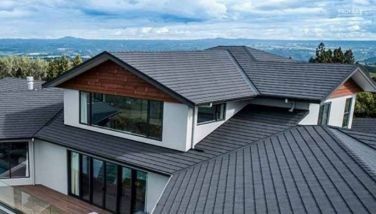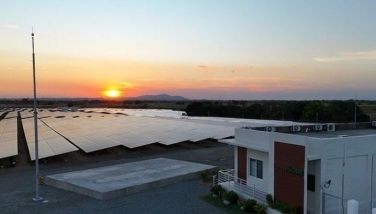Economy grows 5.5% in Q1
June 1, 2006 | 12:00am
The Philippine economy grew a robust 5.5 percent in the first quarter, well above the 4.2-percent growth rate in the same period last year, stirring optimism for the rest of the year as good weather fostered a rebound in the farm sector, government officials said yesterday.
The National Statistical Coordination Board (NSCB) said the increase in gross domestic product (GDP) was due to a recovery of agricultural output and a continuing strong performance in the services sector.
The first quarter GDP figure was within the five- to six-percent range forecast by private economists while Socioeconomic Planning Secretary Romulo Neri said it hit the high-end of government estimates of between five to 5.5 percent. A survey by Dow Jones Newswires of six economists projected first quarter GDP growth in the range of 5.2 percent to 5.5 percent.
Gross national product (GNP), which includes additional income such as the billions of dollars in remittances from some eight million Filipinos working overseas, grew 5.8 percent in the first quarter, up from 4.9 percent a year earlier.
Neri said GDP growth came "in the face of serious challenges," such as the rising price of oil, a "tight fiscal situation," and an attempt to oust President Arroyo in February that prompted her to declare a week-long state of emergency.
In a statement in Malacañang, President Arroyo said the stability of the economy "shows the gains from the economic reforms that have been implemented."
"With our improved fiscal performance, the govenrment can fund priority infrastructure programs to link up the entire country and open up economic activities as well as fund key social and basic services," she added.
The services sector showed "resilience," growing 6.2 percent compared with 7.0 percent in the first quarter of 2005.
Agriculture, which accounts for a fifth of the domestic economy, recovered with a growth of 3.8 percent after a 0.5 percent decline a year earlier as improved weather boosted rice and corn production. The industrial sector, meanwhile, rose 5.5 percent, up from 3.4 percent.
The announcement of high GDP growth helped cushion the downturn of the Philippine Stock Exchange composite index which fell by only 0.17 percent, far less than other regional markets hit by sharp losses on Wall Street.
Neri said the first quarter results boosted confidence that GDP growth would hit the government forecast of 5.5 - 6.2 percent for 2006 after 5.0 percent in 2005.
"Our expectation is anchored on resilient personal consumer spending growth, the recovery of agriculture, the improving prospects of construction and the continued brisk growth of services," Neri added.
Neri conceded, however, that "real significant downside risks to our economic growth exist," citing external concerns such as oil prices, "rising US interest rates, the threat of avian flu and of late, the volatilities in the international financial markets."
Victor Abola, an economist at the University of Asia and the Pacific said GDP would likely grow at a steady pace of 5.0 percent this year due to the impact of high oil prices.
"I’m cautiously optimistic about the economy’s performance this year. I’m looking at a full-year growth of 5.0 percent but actual growth could be lower because high oil prices could impact on the purchasing power of Filipinos in the coming months," Abola said.
He said increased spending on infrastructure had helped boost growth in the first quarter but he also expressed doubt that such large-scale spending could continue beyond the second quarter of the year.
Legislators, however, expressed disappointment that the Arroyo administration has downgraded its growth projections for 2006 from 6.5 - 7.5 percent to 5.9 - 6.5 percent, saying that reducing poverty incidence requires at least a 7.0-percent growth in the domestic economy.
In his presentation before Congress, Neri said growth projections were based on the projected performance of the agriculture, industry and services sector, where industry was projected to be less robust than expected.
Under its Medium Term Development Program, the Arroyo administration had projected a 6.5 - 7.5 percent rise in GDP this year but this has since been trimmed down.
Neri said the latest projections were made by the Development Budget Coordinating Committee (DBCC) which he described as "more conservative" when making projections.
Rep. Joey Salceda, chairman of the House Committee on Economic Affairs, said the latest DBCC projections has made it unlikely for the Arroyo administration to meet its target of achieving a 7.0 percent domestic growth rate by 2010.
"The President is aspiring to turn the country into a first world country by 2010 and these projections made that goal seem more distant," Salceda said. "These maybe projections but we should have targets that are more aggressive than conservative."
"Growth should be by design," added Sen. Manuel Roxas II, Salceda’s counterpart in the Senate. "The economy could have retreated just as easily if we had bad weather. This is not the kind of growth we want to see, we want good numbers to result from design rather than the luck of having good weather."
According to Neri, on the other hand, pump-priming by the government could only go so far, especially since Congress has not approved the 2006 budget.
"If we had a clear mandate on the budget, we could move more aggressively," Neri said.
Salceda expressed concern that given the Arroyo administration’s growth projections, the goal of poverty reduction is also at risk.
"If the economy grows below seven percent per year, then we can not go below where we are now, in terms of poverty incidence," Salceda said. "It’s not a complex concept–the only way you reduce poverty is by economic growth."
Salceda said that since the government does not want to take aggressive action against population growth, its aggressive actions should instead be channeled towards growing the economy. – AFP, AP, Des Ferriols
The National Statistical Coordination Board (NSCB) said the increase in gross domestic product (GDP) was due to a recovery of agricultural output and a continuing strong performance in the services sector.
The first quarter GDP figure was within the five- to six-percent range forecast by private economists while Socioeconomic Planning Secretary Romulo Neri said it hit the high-end of government estimates of between five to 5.5 percent. A survey by Dow Jones Newswires of six economists projected first quarter GDP growth in the range of 5.2 percent to 5.5 percent.
Gross national product (GNP), which includes additional income such as the billions of dollars in remittances from some eight million Filipinos working overseas, grew 5.8 percent in the first quarter, up from 4.9 percent a year earlier.
Neri said GDP growth came "in the face of serious challenges," such as the rising price of oil, a "tight fiscal situation," and an attempt to oust President Arroyo in February that prompted her to declare a week-long state of emergency.
In a statement in Malacañang, President Arroyo said the stability of the economy "shows the gains from the economic reforms that have been implemented."
"With our improved fiscal performance, the govenrment can fund priority infrastructure programs to link up the entire country and open up economic activities as well as fund key social and basic services," she added.
The services sector showed "resilience," growing 6.2 percent compared with 7.0 percent in the first quarter of 2005.
Agriculture, which accounts for a fifth of the domestic economy, recovered with a growth of 3.8 percent after a 0.5 percent decline a year earlier as improved weather boosted rice and corn production. The industrial sector, meanwhile, rose 5.5 percent, up from 3.4 percent.
The announcement of high GDP growth helped cushion the downturn of the Philippine Stock Exchange composite index which fell by only 0.17 percent, far less than other regional markets hit by sharp losses on Wall Street.
Neri said the first quarter results boosted confidence that GDP growth would hit the government forecast of 5.5 - 6.2 percent for 2006 after 5.0 percent in 2005.
"Our expectation is anchored on resilient personal consumer spending growth, the recovery of agriculture, the improving prospects of construction and the continued brisk growth of services," Neri added.
Neri conceded, however, that "real significant downside risks to our economic growth exist," citing external concerns such as oil prices, "rising US interest rates, the threat of avian flu and of late, the volatilities in the international financial markets."
Victor Abola, an economist at the University of Asia and the Pacific said GDP would likely grow at a steady pace of 5.0 percent this year due to the impact of high oil prices.
"I’m cautiously optimistic about the economy’s performance this year. I’m looking at a full-year growth of 5.0 percent but actual growth could be lower because high oil prices could impact on the purchasing power of Filipinos in the coming months," Abola said.
He said increased spending on infrastructure had helped boost growth in the first quarter but he also expressed doubt that such large-scale spending could continue beyond the second quarter of the year.
Legislators, however, expressed disappointment that the Arroyo administration has downgraded its growth projections for 2006 from 6.5 - 7.5 percent to 5.9 - 6.5 percent, saying that reducing poverty incidence requires at least a 7.0-percent growth in the domestic economy.
In his presentation before Congress, Neri said growth projections were based on the projected performance of the agriculture, industry and services sector, where industry was projected to be less robust than expected.
Under its Medium Term Development Program, the Arroyo administration had projected a 6.5 - 7.5 percent rise in GDP this year but this has since been trimmed down.
Neri said the latest projections were made by the Development Budget Coordinating Committee (DBCC) which he described as "more conservative" when making projections.
Rep. Joey Salceda, chairman of the House Committee on Economic Affairs, said the latest DBCC projections has made it unlikely for the Arroyo administration to meet its target of achieving a 7.0 percent domestic growth rate by 2010.
"The President is aspiring to turn the country into a first world country by 2010 and these projections made that goal seem more distant," Salceda said. "These maybe projections but we should have targets that are more aggressive than conservative."
"Growth should be by design," added Sen. Manuel Roxas II, Salceda’s counterpart in the Senate. "The economy could have retreated just as easily if we had bad weather. This is not the kind of growth we want to see, we want good numbers to result from design rather than the luck of having good weather."
According to Neri, on the other hand, pump-priming by the government could only go so far, especially since Congress has not approved the 2006 budget.
"If we had a clear mandate on the budget, we could move more aggressively," Neri said.
Salceda expressed concern that given the Arroyo administration’s growth projections, the goal of poverty reduction is also at risk.
"If the economy grows below seven percent per year, then we can not go below where we are now, in terms of poverty incidence," Salceda said. "It’s not a complex concept–the only way you reduce poverty is by economic growth."
Salceda said that since the government does not want to take aggressive action against population growth, its aggressive actions should instead be channeled towards growing the economy. – AFP, AP, Des Ferriols
BrandSpace Articles
<
>
- Latest
- Trending
Trending
Latest
Trending
Latest
Recommended






















